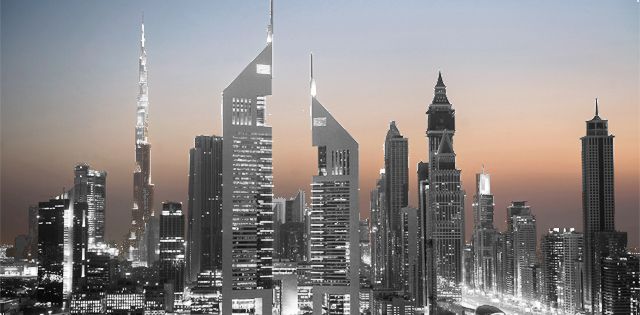They are helped by more multinationals consolidating regional operations in Dubai
Dubai: Dubai’s office properties — and the Grade A addresses in particular — are seeing some heavy activity on the leasing side. And, in some cases, it is coming about at the expense of landlords elsewhere in the Gulf.
“What we see is a continuing migration of multinational occupiers to the Dubai office market,” said Nicholas Maclean (left), regional Managing Director at CBRE, the consultancy. “Existing occupiers are moving to better properties or consolidating where they are.
“At the same time, some are combining several offices within Dubai or within the GCC. We have seen migration of occupiers from Doha and Bahrain to Dubai. Clearly, if you are combining a Doha office and an existing Dubai office, you will need larger accommodation in Dubai.
“There are international tenants who have several offices [in the Gulf] now bringing them to one location in Dubai.
“But the biggest problem has mostly been about the labour pool. Frustrations with recruitment is the number one problem affecting businesses in the region as a whole. The depth of the labour pool in Dubai is simply deeper than anywhere else in the region, and that’s a major reason why (international) businesses want to consolidate here.
“Quality buildings are doing quite well and are pretty much full in spite of there being a high degree of vacancy as a whole.”
Clearly, someone’s loss of a tenant in one Gulf city is turning into pockets of opportunities for Dubai’s office landlords. And the flight to quality is creating fresh opportunities on the sales side as well.
Popular with investors
According to CBRE, recent months have seen the closing of fairly big-ticket transactions involving entire office buildings in Dubai. “There have been one or two, of between Dh300 million to Dh600 million,” said Maclean. “The best locations along Shaikh Zayed Road, the Tecom area and Downtown are proving popular with investors.
“There is now no shortage of people looking at this market, both locally and from the GCC. These can be high net worth individuals, family offices, some institutional interest and even sovereign funds are looking here for office assets. They believe in the Dubai story … and they look at the occupiers who are here.
“Longer leases made out to international corporate tenants is in itself an attractive proposition to investors.” And, once again, master-developers are including office properties into their new project mix. Some much-delayed office-only developments could also be in for a revival of interest.
For tenants, there is no such thing that only high-rises will do. All along Shaikh Zayed Road, between Interchange 1 and that leading into Mall of the Emirates, low-rise office blocks are either opening or being built. The tenants are not just limited to auto dealerships, clinics or F&B operators. In the majority of the new builds, the niche office/retail properties have secured tenants.
ICD Brookfield
Then there are the mid-rises at the sprawling One Central cluster, part of the expansion at Dubai World Trade Centre district. Phase 1 is “fully let” and these are offices with sizeable floor-plates.
And if it is a high-rise that tenants fancy, even those are coming through. Not many can get bigger than what ICD Brookfield will be building — all of 1 million square feet — at DIFC.
“There will be a significant portion of the building that will be pre-let, said Maclean, “even though completion is 18 months away. That’s quite unusual for the Middle East market.
“Tenants believe the developer will build on time and because of Brookfield’s involvement, [and] international institutions are prepared to put down a big stake.
“ICD Brookfield will have a “dreadnought effect” on this marketplace. When that comes online, it will force others wanting to compete in that space to raise their standards.” (Dreadnoughts were huge battleships that all the big maritime powers of the early 20th century wanted to have. If one nation built a new one, the others had to have theirs … or even more of them.)
Thankfully, for longer term sustainability, Dubai’s office property market will not be seeing a rush of new Grade A supply coming through in the next two to three years. This is quite different from the situation in the residential space, where developers are doubling down with their launches, even though at some point, this will start telling on take-up rates.
More measured new supply will also mean a chance for existing second and third-tier office properties to raise their game, if they can. Otherwise, they will run the risk of being stuck with more vacancies or longer periods to secure tenants.
There could even be competition from new quarters. “Until now, the government and its entities have been major owner-occupiers of office buildings here,” said Maclean. “if instead of holding them, those buildings can become trading commodities and generate money for the country. It is the single biggest opportunity available. “This way the market can see create more liquidity and attract a lot more of international capital.”
Factbox: What tenants are looking for — and getting — at Dubai’s premium offices
* Landlords with Grade A office properties are offering large floor-plates, of between 15,0000-50,000 square feet, and not interrupted by pillars. Good centralised services and flexible fitouts are part and parcel of the leasing contracts. Developers with high-profile ongoing projects are also making sure they complete to preset deadlines.
* Rental growth gains and increases in (property) value are happening at prime office buildings in Dubai. “You have a factor of two on the relative value of your income going forward,” said Nicholas Maclean of CBRE M.E. “That’s happening for the best buildings in Dubai. This is not a market phenomena, but a component of market phenomena.”
All rights reserved to the initial publisher for gulfnews.
Collected and published by Arms &McGregor International Realty® editorial team. Get in touched with us at [email protected]

